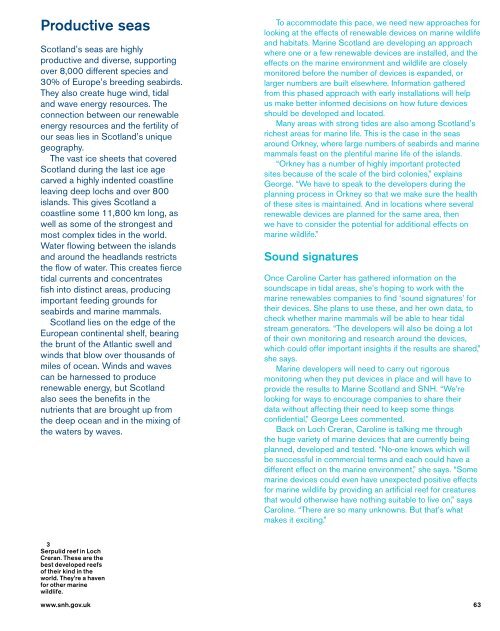You also want an ePaper? Increase the reach of your titles
YUMPU automatically turns print PDFs into web optimized ePapers that Google loves.
Productive seas<br />
<strong>Scotland</strong>’s seas are highly<br />
productive and diverse, supporting<br />
over 8,000 different species and<br />
30% <strong>of</strong> Europe’s breeding seabirds.<br />
<strong>The</strong>y also create huge wind, tidal<br />
and wave energy resources. <strong>The</strong><br />
connection between our renewable<br />
energy resources and the fertility <strong>of</strong><br />
our seas lies in <strong>Scotland</strong>’s unique<br />
geography.<br />
<strong>The</strong> vast ice sheets that covered<br />
<strong>Scotland</strong> during the last ice age<br />
carved a highly indented coastline<br />
leaving deep lochs and over 800<br />
islands. This gives <strong>Scotland</strong> a<br />
coastline some 11,800 km long, as<br />
well as some <strong>of</strong> the strongest and<br />
most complex tides in the world.<br />
Water flowing between the islands<br />
and around the headlands restricts<br />
the flow <strong>of</strong> water. This creates fierce<br />
tidal currents and concentrates<br />
fish into distinct areas, producing<br />
important feeding grounds for<br />
seabirds and marine mammals.<br />
<strong>Scotland</strong> lies on the edge <strong>of</strong> the<br />
European continental shelf, bearing<br />
the brunt <strong>of</strong> the Atlantic swell and<br />
winds that blow over thousands <strong>of</strong><br />
miles <strong>of</strong> ocean. Winds and waves<br />
can be harnessed to produce<br />
renewable energy, but <strong>Scotland</strong><br />
also sees the benefits in the<br />
nutrients that are brought up from<br />
the deep ocean and in the mixing <strong>of</strong><br />
the waters by waves.<br />
To accommodate this pace, we need new approaches for<br />
looking at the effects <strong>of</strong> renewable devices on marine wildlife<br />
and habitats. Marine <strong>Scotland</strong> are developing an approach<br />
where one or a few renewable devices are installed, and the<br />
effects on the marine environment and wildlife are closely<br />
monitored before the number <strong>of</strong> devices is expanded, or<br />
larger numbers are built elsewhere. Information gathered<br />
from this phased approach with early installations will help<br />
us make better informed decisions on how future devices<br />
should be developed and located.<br />
Many areas with strong tides are also among <strong>Scotland</strong>’s<br />
richest areas for marine life. This is the case in the seas<br />
around Orkney, where large numbers <strong>of</strong> seabirds and marine<br />
mammals feast on the plentiful marine life <strong>of</strong> the islands.<br />
“Orkney has a number <strong>of</strong> highly important protected<br />
sites because <strong>of</strong> the scale <strong>of</strong> the bird colonies,” explains<br />
George. “We have to speak to the developers during the<br />
planning process in Orkney so that we make sure the health<br />
<strong>of</strong> these sites is maintained. And in locations where several<br />
renewable devices are planned for the same area, then<br />
we have to consider the potential for additional effects on<br />
marine wildlife.”<br />
Sound signatures<br />
Once Caroline Carter has gathered information on the<br />
soundscape in tidal areas, she’s hoping to work with the<br />
marine renewables companies to find ‘sound signatures’ for<br />
their devices. She plans to use these, and her own data, to<br />
check whether marine mammals will be able to hear tidal<br />
stream generators. “<strong>The</strong> developers will also be doing a lot<br />
<strong>of</strong> their own monitoring and research around the devices,<br />
which could <strong>of</strong>fer important insights if the results are shared,”<br />
she says.<br />
Marine developers will need to carry out rigorous<br />
monitoring when they put devices in place and will have to<br />
provide the results to Marine <strong>Scotland</strong> and SNH. “We’re<br />
looking for ways to encourage companies to share their<br />
data without affecting their need to keep some things<br />
confidential,” George Lees commented.<br />
Back on Loch Creran, Caroline is talking me through<br />
the huge variety <strong>of</strong> marine devices that are currently being<br />
planned, developed and tested. “No-one knows which will<br />
be successful in commercial terms and each could have a<br />
different effect on the marine environment,” she says. “Some<br />
marine devices could even have unexpected positive effects<br />
for marine wildlife by providing an artificial reef for creatures<br />
that would otherwise have nothing suitable to live on,” says<br />
Caroline. “<strong>The</strong>re are so many unknowns. But that’s what<br />
makes it exciting.”<br />
3<br />
Serpulid reef in Loch<br />
Creran. <strong>The</strong>se are the<br />
best developed reefs<br />
<strong>of</strong> their kind in the<br />
world. <strong>The</strong>y’re a haven<br />
for other marine<br />
wildlife.<br />
www.snh.gov.uk 63

















